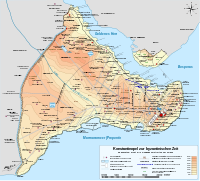Pera

|
| History of Istanbul |
|---|
Pera was the name of a district of Constantinople . It was north of the Golden Horn in the European part of the city. Today the place is part of the Beyoğlu district of Istanbul .
Surname
The word Pera means 'over there' in Greek, which refers to the location opposite the old town, on the other side of the Golden Horn. During the Byzantine Empire, the unpopulated area was called Pera Fields.
The name Pera as the earlier name of parts of today's Beyoğlu district can be found in literature up to the 19th century, for example in Karl May (“From Baghdad to Stambul”), where the name “Great Pera Street” is still used for today's pedestrian zone İstiklal Caddesi "Is used, which corresponds to the French original name Grande rue de Péra and the Ottoman Cadde-i kebir ('big street').
history

Pera was founded in the 13th century as a Genoese trading colony. The center visible from afar is the Galata Tower , which was built by the Genoese in the 14th century and was part of the fortress wall.
In 1273 Pera was given to the Republic of Genoa by the Byzantine Emperor Michael VIII Palaiologos , as thanks for their support in the reconquest of Constantinople in 1261. Pera developed into a flourishing trading colony. After the conquest of Constantinople on May 29, 1453 by the Ottomans , Pera also had to submit to the Ottoman Sultan a few days later, on June 3.
development
Pera was the most western part of Istanbul in the Ottoman Empire. Because of the good water supply, many people had settled here, after 1492 the foreign embassies also moved here, whose residences created a great variety of styles. Hospitals soon followed suit. The Ottoman government supported this development by building palaces, schools and official buildings. Pera did not develop into a district outside the old wall around Galata until the Ottoman period , which was also mainly inhabited by Italians ( Venetians and Genoese).
Sultan Mahmut II continued the developments of his predecessor Selim III. continued, during his reign Pera shone in new splendor and differed significantly in appearance, lifestyle and clothing of the inhabitants from the rest of Istanbul. Between 1860 and 1864 two cemeteries and the old city wall were demolished and new roads built. On June 5, 1870, a major fire broke out in Pera, which destroyed at least 3,000 houses and caused the deaths of around 1,300 residents. In 1875 the underground funicular that connects Pera with the Galata Bridge was put into operation. In 1913 the first electric trams ran.
Famous became the Hotel Pera Palas (Meşrutiyet Caddesi 98, Beyoğlu), which was built in 1892 to accommodate the guests of the Orient Express and housed celebrities such as Agatha Christie , Greta Garbo , Mata Hari , Sarah Bernhardt and Mustafa Kemal Ataturk . The traditional hotel is true to the original and is currently being restored.
Sons and daughters of Pera
- Johann Heinrich Mordtmann (1852–1932), German orientalist and diplomat.
literature
- Franz von Caucig: From Constantinople to Istanbul. Private printing, Nuremberg no year
- Edhem Eldem : Ottoman Galata and Pera between myth and reality. In: Ulrike Tischler (ed.): From “milieu de mémoire” to “lieu de mémoire”. The cultural memory of Istanbul in the 20th century. Martin Meidenbauer Verlagbuchhandlung, Munich 2006, ISBN 3-89975-063-2 , pp. 19–36 ( online ).
- Carsten Meyer-Schlichtmann: From the Prussian Legation to the Doğan-Apartmanı . 130 years of a house in Beyoğlu . İstanbul Kitablığı, Istanbul 1992, ISBN 975-7687-09-X .
Individual evidence
- ↑ Cornel Zwierlein: From the beginning and the end of the early modern period - or: Did Constantinople burn in the modern age in 1870 and London in 1666 in the early modern period? in: Mitteilungen 1/2009 Universität München (PDF; 7.4 MB), requested on June 4, 2011
Coordinates: 41 ° 2 ′ N , 28 ° 59 ′ E
